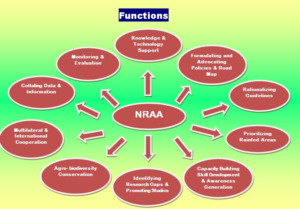About NRAA
- NRAA was established as per decision of Cabinet on 3rd November 2006 as an expert body of Ministry of Agriculture to provide the much needed knowledge inputs regarding systematic up-gradation and management of country’s dry land and rainfed agriculture.
- The Authority is serviced by the Ministry of Agriculture and is located at Delhi.
- The Authority is an advisory, policymaking and monitoring body charged with examining guidelines in various existing schemes and in the formulation of new schemes including all externally aided projects in this area.
- The NRAA has formulated common guidelines for the Watershed Development Project and is in consultation with all the States for its implementation as per instructions contained in the guidelines.
- The Authority has published the Common Guidelines for Watershed Development Projects with a fresh framework for next generation watershed programmes.
- The Governing Board is chaired by the Union Agriculture Minister and co-chaired by the Union Minister of Rural Development.

Area of Focus Point
- Net-working and coordination with the Key Ministries of Agriculture & Farmers Welfare, Rural Development, Water Resources, Environment & Forests and Panchayati Raj.
- Focus on convergence, coordination, value addition, capacity building and monitoring & Evaluation.
- Meeting challenges of emerging policies, technologies, marketing, social and economic changes.
- IT enabled project planning and management.
- Enabling institutions for effective governance and service delivery.
- Pilot projects for upgrading rainfed systems in selected high priority areas.
The mandate of the Authority includes
- To prepare a perspective plan, outlining the national strategy and road map for holistic and sustainable development of rainfed farming areas.
- To evolve common guidelines for all schemes of different Ministries, including EAPs for development of Rainfed/Dry land Farming systems.
- To coordinate and bring convergence within and among agricultural and wasteland development programmes being implemented in rainfed areas of the country.
- To identify rainfed areas in different States which need priority attention and prepared watershed development programmes for integrated natural resource management in consultation with States, focusing on multi dimensional crop, livestock, horticulture, agri-pasture integrated systems and programmes for landless farming communities.
- To identify gaps in input supply, credit availability, dissemination of appropriate technology and other requirements relevant for rainfed areas.
- Guide the implementing agencies on priority setting and monitor the specific interventions required.
- To develop plans/programmes for capacity building of Centre/State Government functionaries in rainfed areas.
- To suggest modalities to strengthen National and State Level Institutions concerned with Rainfed/Dryland areas, and establish institutional linkages with prioritized watersheds.
- Monitor disbursement of rural credit/insurance cover/safety net programmes developed for rainfed areas.
- Set the research agenda including a critical appraisal of on-going programmes and promote diffusion of required knowledge for integrated farming in rainfed areas to district and lower level authorities.
- To evaluate the effectiveness of completed watersheds and concurrent evaluation of on-going programmes.
Source: PIB
















